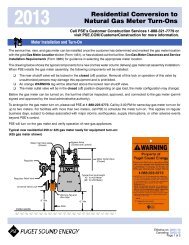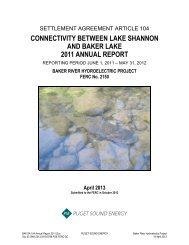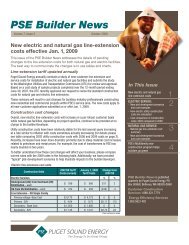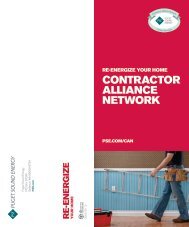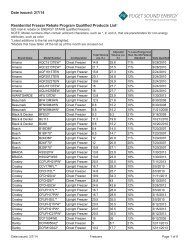ENERGY EFFICIENT INSULATION - Puget Sound Energy
ENERGY EFFICIENT INSULATION - Puget Sound Energy
ENERGY EFFICIENT INSULATION - Puget Sound Energy
You also want an ePaper? Increase the reach of your titles
YUMPU automatically turns print PDFs into web optimized ePapers that Google loves.
RE-ENERGIZE YOUR HOME<strong>ENERGY</strong><strong>EFFICIENT</strong><strong>INSULATION</strong>PSE.COM/ReENERGIZE
RE-ENERGIZEYOUR HOME,YOUR COMFORT,YOUR SAVINGSKeeping your home comfortable is usually the biggestuse of energy. Insulation and efficient windows can trapin your winter warmth and shield you from the summersun. Choosing the right products and installing themcorrectly can be an investment that saves energy andmakes you more comfortable.About <strong>Puget</strong> <strong>Sound</strong> <strong>Energy</strong>Washington state’s oldest local energy utility, <strong>Puget</strong><strong>Sound</strong> <strong>Energy</strong> serves 1.1 million electric customersand more than 760,000 natural gas customers in10 counties. A subsidiary of <strong>Puget</strong> <strong>Energy</strong>, PSEmeets the energy needs of its customers, in part,through cost-effective energy efficiency, procurementof sustainable energy resources, and far-sightedinvestment in the energy-delivery infrastructure. PSEemployees are dedicated to providing great customerservice that is safe, dependable and efficient. Formore information, visit www.PSE.com.2
KNOWING WHERE TOSTART YOUR SEARCHISRE-ENERGIZINGResources• PSE <strong>Energy</strong> Advisors: 1-800-562-1482• PSE.com/ReENERGIZE• energystar.gov• efficientwindows.org<strong>Energy</strong> IQLow-emittance (Low-E) window: This is a windowthat has a thin coating that makes it have a lowerU-factor (in other words, makes it harder for heat tomove through it).R-value: This is a measure of how much a surfaceresists heat transfer. So the higher the R-value,the better insulated and more comfortable you willtend to be. R-values range from R-0 (no insulation)to R-49 (an attic with approximately 16 inchesof insulation).Solar heat gain coefficient (SHGC): This isa measure of a window’s shading ability. A lowernumber will protect you more from the summer sun.Values may range from .2 to .8. If you are mainlyinterested in reducing your cooling needs in thesummer, choose a SHGC of less than .4.U-factor (or U-value): This is a measure of howmuch a surface allows heat to transfer through it.A lower U-factor window is better at keeping youcomfortable. Single-pane windows are approximatelyU-1. Most building codes and <strong>ENERGY</strong> STARstandards require windows to have a U-factor of atleast U-.30.Weatherization: This is the process of improvingthe “enclosure” around your home. This includesadding insulation in your attic, floors and walls;upgrading your windows; and sealing leaks.11
UNDERSTANDINGWEATHERIZATIONISRE-ENERGIZINGHow does weatherizing make my homemore comfortable?The condition of your home’s outer shell, or enclosure, is whatdetermines how fast your home loses heat in the winter orhow much of the sun’s heat it shields in the summer.Many homes built before 1980 energy codes were in placemay have thin, leaky windows and only one layer of woodbetween its occupants’ comfort and the outdoor climate.What does “weatherizing” mean?When you improve the enclosure around your home, you areweatherizing. This includes adding insulation in your attic,floors and walls; improving your windows; and sealing leaks.This “blanket” of warmth adds protection all around your homeand can significantly reduce your energy use. The benefitsof weatherizing with insulation and windows, when they’reinstalled correctly, include making your home:• Warmer in the winter, by trapping the heat in.• Cooler in the summer, by blocking the heat and keepingthe sun’s rays out.• Quieter, by providing a buffer from the sounds outsideyour home.• More energy efficient, by reducing the amount of energyrequired to keep you comfortable.• More valuable when it’s time to sell.Could your home benefit from a weatherizationupgrade?• Was your home built prior to 1980?• Does your house cool down quickly in the winter?• Does your furnace seem to run a lot to maintain aneven temperature?• Are your floors cold?• Is the air in your heating registers too cool or is therenot enough of it in certain rooms?• Does water frequently condense on your windows?Learn how to identify what you have and what you can doabout it.4
RE-ENERGIZEWITH AQUALIFIEDCONTRACTORHow do I find a qualified contractor?When choosing contractors, make sure they are licensed,insured and bonded. In addition, they should secure allnecessary permits to ensure that equipment is installed inaccordance with applicable safety codes. A quality homeimprovement purchase requires both the right product andthe right contractor. To find a contractor, call a PSE <strong>Energy</strong>Advisor at 1-800-562-1482 or visit PSE.com/CANWhat do I ask for?When you call a contractor, say:• “I want my house weatherized.”• “I want R-49 insulation in my attic, R-30 in my floor andat least R-11 in my walls.”• “I want <strong>ENERGY</strong> STAR ® qualified windows with aU-factor of .30 or lower.”• “I want duct sealing done by a qualified contractortrained in identifying duct leakage. I want my home to bemore comfortable, efficient and safe.”<strong>Energy</strong> IQIdeally, the living space is completely surrounded byinsulation except where there are windows and doors. Thistable shows the recommended efficiency levels for eachpart of your home.If you have thisR-0 to R-19 attic (up to 6”)insulationR-0 floorFloor insulation falling downGarage ceiling R-0R-0 wallDucts that leakBare metal ductsMetal-framed double-panewindowsSingle-pane windowsUpgrade to thisR-38 to R-49 (approximately13”-16”)R-30 to R-38 (approximately10-13”)R-30 to R-38 (approximately10-13”)Blow fullR-11 to R-19 (depending on wallstud size)Sealed and tested ductsR-11 insulation for ducts<strong>ENERGY</strong> STAR qualified U-.30or lower<strong>ENERGY</strong> STAR qualified U-.30or lowerR-2 simple wood door R-15 insulated metal door 9
RE-ENERGIZETHE WAY YOUTHINK ABOUTHOME <strong>INSULATION</strong>What products are out there?Insulation productsFiberglass and cellulose fiber are the two most common atticinsulation materials. Fiberglass is made of billions of strandsof extruded glass fibers packed into batts. Cellulose consistsof ground-up newspaper material, which is then treated withfire-retardant chemicals. Both types work well. Contractorsusually blow the insulation material into wall and attic cavitieswith a hose and install batts in floor cavities.FloorCold air enters thehouse throughuninsulated floors.FoundationInsulatedUninsulatedCrawl spaceWindow productsThe two key factors to shop for include, U-factor (also knownas U-value) and solar heat gain coefficient (SHGC).Choose a window with a U-factor of .30 or lower. If you needto block summer heat, look for products whose SHGC is lessthan .4. If you want the sun to help heat your house, look forproducts whose SHGC is up to .8.Other features includecoatings on glass orplastic films within thewindow assembly thatcan significantly reduceultraviolet (UV) and othersolar radiation, whichcauses fading of fabricsand furnishings. Efficientwindows often havecoatings (such as “Low-E”coatings) that improve theirefficiency with a minimal loss of visible light (compared toolder tints and films).10
In this guideThis guide contains information to help youunderstand how to increase your comfortand lower your energy costs by investing ininsulation and windows.4 Understanding weatherization5 The basics of home insulation6 Insulated windows7 Important installation techniques9 Finding the right contractor10 What products are out there?11 Resources3
RE-ENERGIZEWITH PROPERHOME <strong>INSULATION</strong>TECHNIQUESWhat installation techniques are mostimportant?Insulation and windows that are correctly installed will saveenergy and provide years of comfort. Incorrectly installedinsulation and windows won’t save energy and could cause airquality and moisture-related problems.A good-quality installation includes the following:1. Moisture controlMoisture from cooking and bathing, as well as things likecracks around windows and dryer hoses not directed outside,can make insulation ineffective and cause mold and mildew.Ways to control moisture include:• Using proper venting in the attic and underfloor.Don’t block existing attic or crawlspace venting withnew insulation.• Covering the dirt in the crawl space with plastic.• Making sure bath fans and dryer hoses vent directly tothe outside, not to attic and crawl spaces. Use your fanswhenever you are producing steam.TipsUse your fans and make sure they work. If your bathfan can’t hold up a two-ply sheet of toilet paper, it’s notworking well enough.2. No gaps in insulation or around windowsWhen contractors install insulation, it is very important thatthey do a thorough job. If there are gaps that expose barewood, or if there are gaps around holes that are cut for lightingfixtures or wiring, they can significantly affect your comfortand costs.TipsSeal up leaky drafts around windows and doors withweather-stripping, caulking and door sweeps.7
3. Fixing leaky ductworkDucts carry hot air from your furnace to the registers in yourrooms. It’s not uncommon for leaks to cause more than 25percent of the hot air to escape before reaching your rooms.That means more than a quarter of the money you spend toheat and cool your home could be vanishing into thin air. Ductsealing fixes this problem by:• Reconnecting equipment that has become disconnectedand is blowing hot air into your crawl space.• Repairing gaping holes.• Using permanent sealing materials (not duct tape).BEFOREAtticRoomsLeaky jointsBEFORE4. Window installation with careful framing andmoisture controlModern windows AFTER stay warmer Attic to the touch, so moist air isless likely to condense on them, and when you sit next tothem, you’ll feel more comfortable. Proper window installationAttictechniques prevent water from the outside (e.g., driving rain,Roomssprinkler water) from seeping into the wall cavity around theperimeter of the window. Make sure the contractor explainshow he or she will ensure that Rooms the window will not leak waterinto the wall. Techniques include:Leaky jointsCrawl spaceDisconnectedfrom house(blowing into• Using the proper sealants. Collapsed duct crawl space)• Using “flashing” materials Crawl space that direct water to draintoward the outside of your walls, not toward the inside.AFTERCrawl spaceCollapsed ductDuctwork is repaired andleaks are sealed.Disconnectedfrom house(blowing intocrawl space)AtticRoomsCrawl space8Ductwork is repaired andleaks are sealed.
<strong>Puget</strong> <strong>Sound</strong> <strong>Energy</strong>P.O. Box 97034Bellevue, WA 98009-9734PSE.com/ReENERGIZERE-ENERGIZEYOUR HOME <strong>INSULATION</strong>4326 06/13



